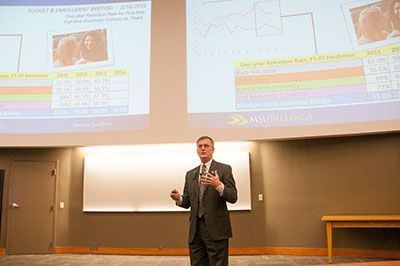University Communications and Marketing
Student retention and persistence is vital to the growth of the university
February 17, 2016
»» View video recording of the Budget and Enrollment Briefing
Contacts:
Carmen Price, University Relations & Communications, 657-2269
Aaron Clingingsmith, University Relations & Communications, 657-2243
MSU BILLINGS NEWS SERVICES — Amid declining state-wide high school enrollment, Chancellor Mark Nook has set a new objective of raising the retention rate at Montana State University Billings by 10 percentage points in five years.
Nook shared his goal for an increase in student retention and graduation rates—and how both would tie in with increasing enrollment and growing the university’s profile—during a campus-wide budget and enrollment briefing on Tuesday afternoon.
One-year retention rates for first-time freshman have hovered around 55 percent for the past five years, Nook said, while peer-universities such as Black Hills State, University of Montana Western and Bemidji State University with similar academic backgrounds have retained upward of 65 percent of their full-time freshman cohorts.
“I ask the university to work on moving our retention rate from what is our five-year average of 55 percent to 65 percent in the next five years, a two percentage point increase per year,” Nook proposed to group of about 200 faculty and staff.
“That’s a pretty healthy lift, and it’s going to take some work,” he said.
Assuming the freshman class size doesn’t change in five years, Nook said that by retaining the additional students would net 130 full-time equivalent by 2020, and 181 FTE by 2025.
The outcome, he said, not only improves the university’s status and standard, but will have an invariable positive effect on enrollment.
“Retention and persistence is going to be vital,” he said, noting that high school graduation numbers in Montana will not rise appreciably in the next 12 years. “The number of students graduating from Montana high schools will remain relatively flat for the next decade so it is vital that we improve our enrollment through retention and persistance.”
As of Feb. 9—the 15th day of the semester—MSUB’s headcount was 4,163 and FTE of 3,158. Of those students enrolled last semester, the university retained 90.7 percent, a 2.7 percent increase compared with the same point last year.
This is good news, Nook said, that the 90.7 percent Fall to Spring return rate provided the university an additional $300,000 when compared to the previous year’s Fall to Spring return rate of only 88 percent.
Formed this time last year, a Student Success Committee, led by Vice Provost Matt Redinger and composed of faculty, staff, students and community members, has laid out a roadmap of how to achieve the proposed retention goal.
On the top of the committee’s recommendations to improve retention rates and degree completions is strategic use of scholarship reserves. Another priority set forth by the committee is to implement a student progress alert system that will detect early on into the semester when a student may need supplemental instruction.
The funding for the initiatives will come from performance-based funds—a state funding system implemented two years ago that sets aside a portion of higher education dollars contingent upon meeting certain criteria, mostly a score based on retention rates and the number of degrees awarded each year.
Awarded in December, the university must use the allotted amount of $760,000 by the end of the fiscal year, June 30.
“This isn’t going to be a spending spree. It’s going to be an investment in retention, recruiting and marketing,” Nook said, noting that the Executive Budget and University Budget committees have been planning since March how the university would spend the funds if awarded.
In addition to retention efforts, Nook called on faculty and the community to help identify new academic programs the university could offer.
“We need to think creatively and innovatively about what programs our university could offer that will meet Billings and Eastern Montana’s needs,” he said.

